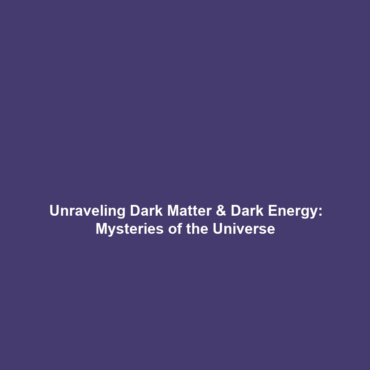The Hubble Constant Controversy: Dark Energy’s Role in the Expanding Universe
The Hubble Constant controversy has emerged as a pivotal debate in modern cosmology, significantly impacting our understanding of dark energy’s role in the expanding universe. This ongoing discussion stems from discrepancies between various measurements of the Hubble Constant, which describes the rate at which the universe is expanding. As researchers probe deeper into this controversy, the implications for dark matter and dark energy become increasingly apparent, highlighting the need for a comprehensive understanding of these cosmic phenomena.
Key Concepts
The Hubble Constant
The Hubble Constant (H₀) quantifies the relationship between the distance to a galaxy and its recessional velocity due to the universe’s expansion. This fundamental parameter is crucial for estimating the age, size, and fate of the universe.
Dark Energy
Dark energy, a mysterious force driving the accelerated expansion of the universe, plays a critical role in the Hubble Constant controversy. Current estimates suggest that dark energy constitutes approximately 68% of the universe, yet its nature remains largely unknown, complicating our understanding of cosmic dynamics.
Applications and Real-World Uses
The implications of the Hubble Constant controversy extend beyond theoretical physics into practical applications:
- Understanding Cosmic Evolution: How the Hubble Constant is used in studying the evolution of galaxies and cosmic structures.
- Cosmic Distance Ladder: Applications of the Hubble Constant in establishing a framework for measuring distances in the universe.
- Astronomical Observations: Utilizing data from telescopes to refine our measurements of the Hubble Constant and enhance our understanding of dark energy.
Current Challenges
Despite advancements in cosmological research, several challenges persist:
- Measurement Discrepancies: Challenges of reconciling different methods of measuring the Hubble Constant, such as distance ladder methods versus cosmic microwave background measurements.
- Dark Energy Characteristics: Issues in accurately characterizing dark energy, which remains poorly understood.
- Technological Limitations: Constraints of current technology in accurately measuring distant astronomical objects.
Future Research and Innovations
As research progresses, several promising avenues are being explored:
- Next-Generation Telescopes: Innovations in telescope technology such as the James Webb Space Telescope aim to provide deeper insights.
- New Theories: Development of alternative cosmological models that may offer explanations for the observed Hubble tension.
- Collaborative Efforts: Increased collaboration between international research teams to standardize measurements.
Conclusion
In summary, the Hubble Constant controversy is a crucial aspect of contemporary cosmology, offering insights into dark energy’s role in the expanding universe. As researchers navigate this complex terrain, more refined measurements and innovative approaches will be essential. To stay informed about future developments in dark matter and dark energy, consider exploring related resources on cosmology.org or our dedicated dark energy section.

